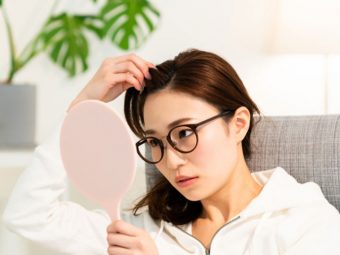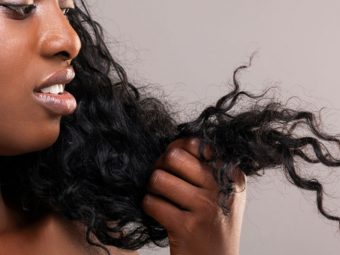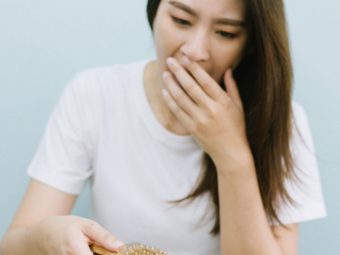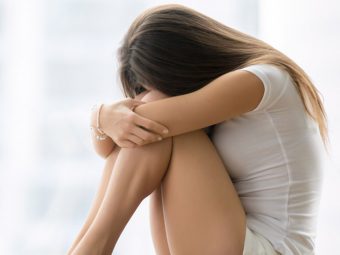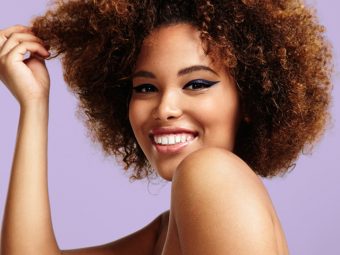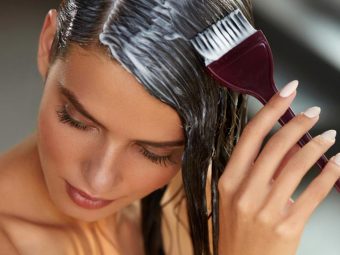Signs Of Hair Thinning And How To Treat It
Spot the signs before they worsen and take prompt action to protect your precious hair.

Image: Shutterstock
We all fear hair thinning. It may affect anyone, irrespective of age and gender, and can be quite distressing. The stress of hair loss and thinning is compounded by the fact that there are many causes. So, finding out the exact reason for hair thinning can be quite challenging.
The good news is, most of the underlying causes of hair thinning can be easily diagnosed and treated. However, an early diagnosis is crucial to start the right treatment and prevent hair loss and thinning. This article has explained the signs of hair thinning and treatment options. Read on to learn more.
In This Article
Signs To Know If Your Hair Is Thinning
Losing a few strands of hair every day is completely normal and nothing to be bothered about. However, if any of the following signs are observed, it might be worrisome:
- Excess Hair In The Shower Drain: If you notice a little more hair shedding than usual, it can be a cause of concern. If the reason for this is a change in shampoo, this shedding might just be because the hair is getting used to the new ingredients. However, if this is being observed over a longer period, chances are your hair is thinning and will require some fixing.
- A Visible Scalp: If you can start seeing your scalp through your hair, it can be because of hair thinning. This happens because the rate at which hair growth occurs is much slower than that of hair loss. The hair’s growing phase, called anagen, decreases and may lead to follicular miniaturization. With follicular miniaturization, your hair grows short and thin. (1)
- Excess Hair Loss When Brushing: If you have skipped combing your hair in the past one or more days, you may expect some excess hair loss that is normal. However, with hair thinning, you will notice more than usual shedding even with regular combing.
- Your Hair Feel Thinner When Tied Up: If your usual hair tie/scrunchie feels loose or needs one more loop than usual when tying your ponytail, it means that your hair has noticeably thinned. This is provided that the hair tie has not lost its elasticity.
The next section discusses the few things one should do if you notice these signs. Follow these before taking any drastic step or jumping to the wrong conclusion.
The First Few Things You Should Do When You Notice Your Hair Is Thinning
- Let Your Hair Breathe: If people find it difficult to breathe in cramped-up spaces, hair does too. Tying or braiding it tightly all the time will stress out your hair and may cause hair fall (2). Go the Rapunzel way and let it down for a while or tie it loosely.
- Check On Your Mental Health: It is said that mental health issues like stress, anxiety, and depression add to hair loss. Some people with mental health issues even pull out their hair (2). Furthermore, the loss of hair has proven to add to the stress, especially on women (3). Book an appointment with a therapist if you are experiencing any mental health concerns.
- Check For Dandruff: Often, dandruff is caused by a fungus (4). The presence of fungus on the scalp may lead to a condition called cicatricial alopecia (2). There are many treatments for dandruff available, so either consult a doctor or try some DIY remedies.
- Stop Heat Styling Your Hair: Applying high heat to your hair can damage it permanently. Try using leave-in conditioners or heat-protectant products before heat styling it (2).
- Check the pH of your shampoo: A study suggests that most commercial shampoos are too alkaline. However, your hair is slightly acidic (5). Switch to a pH-balancing shampoo to reduce hair thinning.
- Keep Vitamin B3, Biotin, And Fatty Acid Levels In Check: The deficiency of these three nutrients has been found to decrease hair growth and increase hair fall (6). In addition, two common types of hair loss, namely androgenetic alopecia and telogen effluvium, were improved when low levels of vitamin D were supplemented (7). However, it is important that a professional diagnose these deficiencies before prescribing supplements.
- Check Your Iron Levels: In people who are anemic, it was seen that iron deficiency led to hair fall. Consult a doctor to get your iron levels checked.
- Eat Protein-Rich Foods: Lean meat, fish, eggs, and nuts can be eaten to increase your protein intake. A deficiency in protein affects the overall health of a person and cause hair loss and thinning (6).
- Consider Hair Treatments: If none of the above-mentioned tips work, it may be worth considering a professional treatment. The different kinds of treatments available are discussed in detail below.
Grace Ford, a YouTuber, shares her experience of hair thinning due to stress. She says that she had been diagnosed with iron deficiency and vitamin D deficiency which can be responsible for her hair loss. She did a lot of other things to stop hair loss and states, “I’ve actually started to use baby shampoo on my hair which is a lot softer because the previous shampoos I would use, it would leave my hair really like chalky and brittley (i).”
The next section will discuss how hair thinning can be treated.
How To Treat Hair Thinning
There are many treatments available that claim to help with hair thinning and hair loss. However, how exactly do these medical treatments work, and how many DIY remedies have any scientific backing? Keep reading to find out.
Medical Treatments:
- Minoxidil: This is a drug that reportedly helps induce hair growth (8). It is recommended to use this drug at the advice of a dermatologist. It might cause irritation or increase in hair fall initially. Hence, always start with a lower amount and then increase the frequency and amount of minoxidil after a few weeks.
- Anti-androgens: This is specifically for women. Androgens are male sex hormones that are given to women to induce hair growth. This should strictly be taken only under the supervision of a doctor (1). This method works only in case of androgenic alopecia where the cause of hair fall is hormone-related.
- Iron Supplements: In people with iron deficiency, it is often found that their hair growth gets affected as well. Hence, eating iron-rich food or taking iron supplements may help with hair thinning (6).
- Hair Transplantation: In this treatment, a narrow strip of scalp is removed over the course of a few sessions. This strip is separated into tiny grafts which are then planted where hair thinning is noticed (1). This procedure is done so that the results are much more realistic (9).
A survey conducted on 1000 US adults between 41-60 years of age revealedthat 42% of participants were struggling with rapid hair loss. 40% of them did not feel very attractive due to that, which affected their confidence level as well. The survey also reported that women showing initial stages of hair loss were willing to invest $4000 on average in hair transplantation, while this median number for those suffering from severe hair loss was as high as $5000.
Apart from medical help, there are a few popular DIY home remedies (backed by research) known to help with hair growth that are discussed in the next section.
DIY Treatments
- Onion Juice: Onion extract is claimed to be miraculous for hair growth. There are also onion extract shampoos available on the market. A study found that using onion juice for hair growth was beneficial (10). This simple DIY can be done by grating onions and extracting the juice through a washcloth. Apply the juice directly to the scalp once or twice a week for 15-30 minutes before showering.
- Witch Hazel: This is a genus of flowering plants that may benefit hair growth (11). There are many hair products available with witch hazel in them.
- Green Tea: Another ingredient popular in the DIY world of hair care is green tea. The epigallocatechin-3-gallate (EGCG) present in green tea has been found to promote hair growth in hair follicles (12).
- Coconut Oil: Protein deficiency is harmful to hair growth. Using coconut oil before and after washing the hair was seen to reduce protein loss in both damaged and undamaged hair (13). It penetrates deep into the hair shaft. In addition to using coconut oil, a study also suggests that a thorough scalp massage helps in increasing hair thickness (14). To make the most of this cheap DIY remedy, apply coconut oil onto the scalp and massage for a few minutes. Leave it on for at least half an hour before washing it off.
- Egg Yolk: A messy and smelly DIY is sure not going to be a pleasant experience, but if using egg yolk works for hair growth, it is only a small price to pay for a much bigger benefit. The water-soluble peptides found in egg yolks may help with hair follicle growth (15). Use it as a part of a DIY hair mask.
- Neem Extract: Neem is popularly known for its antifungal properties. One of the problems caused by fungus is dandruff. The presence of dandruff can clash with hair growth. Neem extract may be beneficial in getting rid of dandruff (16).
- Apple Cider Vinegar: An apple cider vinegar rinse is a simple way to rejuvenate your hair and scalp (17). Add one part apple cider vinegar to two parts water and rinse your hair with this mix after shampooing. This eliminates residue from hair products, balances pH levels, and closes the hair cuticles for added shine and reduced frizz. It is especially beneficial for those with oily hair or dandruff issues.
- Fenugreek Seed Paste: Fenugreek seed paste is a traditional remedy for keeping the hair healthy. Soak the seeds overnight, and grind them to make a paste. Apply this to your scalp and hair as a mask, leave it for 30 minutes, then wash off. Fenugreek is rich in proteins, vitamins, and minerals that strengthen hair, reduce breakage, and promote growth (18). Regular use can help combat hair loss and dandruff, leaving hair silky and smooth. Before trying the above-mentioned remedies, it is always recommended to patch test and stop if any allergic reaction is noticed.
 Quick Tip
Quick TipWhile these DIYs may help reduce hair fall in the long run, you may be wondering what can be done for a quick fix. The following hair hacks will help hide your thinning hair.
Quick Fixes
- Style Your Hair Differently: Apply a volumizing mousse and part your hair on the opposite side to add more bounce and volume and make it look deceptively fuller.
- Use Black/Brown Brow Products: Products used to fill in the eyebrows can also be used to fill in the balding spots on your scalp or thinning hair around the hairline.
- Cut Your Hair Short: A shorter hair cut can make your hair look thicker and healthier. It is also easier to manage.
- Hair Extensions: This is a life hack for people who wants to sport varying hair lengths. Just buy some clip-on hair extensions to add volume to your hair instantly. However, this can be quite expensive.
 Quick Tip
Quick TipHair thinning can affect anyone and is a common problem. From stress and nutritional deficiencies to excessive use of styling products, several reasons can cause hair thinning. If you notice hair thinning, it is best to start treatment as it may help combat it immediately.
Medical treatments and DIY home remedies help treat hair thinning. Also, you can opt for other quick fixes like styling your hair, cutting it short, and using hair extensions to hide hair thinning. Consult your doctor to identify the cause of your hair fall and start the treatment instead of self-diagnosing.
Frequently Asked Questions
Is hair thinning normal?
Yes. Some hair thinning is normal according to a person’s hair growth cycle. However, you should consult a doctor if you see a drastic change in hair volume.
Why is my hair thinning in my 20s?
There could be various reasons behind hair thinning in the 20s, including stress, hormonal changes, diet, and environmental stressors.
Why is my hair so fine and thin?
Fine and thin hair could result from your genetics, hormonal issues, malnourishment, and some medical conditions.
Key Takeaways
- If you lose a lot of hair or notice that you can see your scalp through your hair, chances are your hair might be thinning.
- Consider checking your hair for dandruff, avoiding tight hairstyles, and ditching heat styling tools.
- You may undergo medical treatment or adopt natural home remedies to regain hair health.
Discover the many ways you can treat thinning hair in the video below. Learn how to minimize hair fall and regrow your mane with effective precautions and treatment options. Click play to find out how!
References
Articles on StyleCraze are backed by verified information from peer-reviewed and academic research papers, reputed organizations, research institutions, and medical associations to ensure accuracy and relevance. Read our editorial policy to learn more.
- Treating female pattern hair loss
https://www.health.harvard.edu/staying-healthy/treating-female-pattern-hair-loss - Hair loss: An overview
https://www.researchgate.net/publication/11446462_Hair_loss_An_overview - Psychological effects of androgenetic alopecia on women: comparisons with balding men and with female control subjects
https://pubmed.ncbi.nlm.nih.gov/8408792/ - How to treat dandruff
https://www.medicalnewstoday.com/articles/152844#_noHeaderPrefixedContent - The Shampoo pH can Affect the Hair: Myth or Reality?
https://www.ncbi.nlm.nih.gov/pmc/articles/PMC4158629/ - The Role of Vitamins and Minerals in Hair Loss: A Review
https://www.ncbi.nlm.nih.gov/pmc/articles/PMC6380979/ - The Role of Vitamins and Minerals in Hair Loss: A Review
https://www.ncbi.nlm.nih.gov/pmc/articles/PMC6380979/ - Minoxidil and its use in hair disorders: a review
https://www.ncbi.nlm.nih.gov/pmc/articles/PMC6691938/ - Female pattern hair loss: Current treatment concepts
https://www.ncbi.nlm.nih.gov/pmc/articles/PMC2684510/ - Onion juice (Allium cepa L.), a new topical treatment for alopecia areata
https://pubmed.ncbi.nlm.nih.gov/12126069/ - North American Virginian Witch Hazel (Hamamelis virginiana): Based Scalp Care and Protection for Sensitive Scalp, Red Scalp, and Scalp Burn-Out
https://www.ncbi.nlm.nih.gov/pmc/articles/PMC4158622/ - Human hair growth enhancement in vitro by green tea epigallocatechin-3-gallate (EGCG)
https://pubmed.ncbi.nlm.nih.gov/17092697/ - Effect of mineral oil, sunflower oil, and coconut oil on prevention of hair damage
https://pubmed.ncbi.nlm.nih.gov/12715094/ - Standardized Scalp Massage Results in Increased Hair Thickness by Inducing Stretching Forces to Dermal Papilla Cells in the Subcutaneous Tissue
https://www.ncbi.nlm.nih.gov/pmc/articles/PMC4740347/ - Naturally Occurring Hair Growth Peptide: Water-Soluble Chicken Egg Yolk Peptides Stimulate Hair Growth Through Induction of Vascular Endothelial Growth Factor Production
https://pubmed.ncbi.nlm.nih.gov/29583066/ - ANTIFUNGAL PROPERTIES OF NEEM (AZARDIRACHTA INDICA) LEAVES EXTRACT TO TREAT HAIR DANDRUFF
https://www.researchgate.net/publication/333671637_ANTIFUNGAL_PROPERTIES_OF_NEEM_AZARDIRACHTA_INDICA_LEAVES_EXTRACT_TO_TREAT_HAIR_DANDRUFF - Preparation and Optimization of Garlic Oil/Apple Cider Vinegar Nanoemulsion Loaded with Minoxidil to Treat Alopecia
https://www.ncbi.nlm.nih.gov/pmc/articles/PMC8706394/ - Fenugreek (Trigonella Foenum-Graecum L.) And Its Necessity [Review Paper]
https://www.researchgate.net/profile/Sabyasachi-Chatterjee-3/publication/279038848_Fenugreek_Trigonella_foenum_gracum_L_and_its_necessity_A_Review_Paper/links/5589115b08ae347f9bdad2e9/Fenugreek-Trigonella-foenum-gracum-L-and-its-necessity-A-Review-Paper.pdf
(i) Stress was thinning my hair hair update | My hair loss journey
https://www.youtube.com/watch?v=9vYc1tHcKj8






